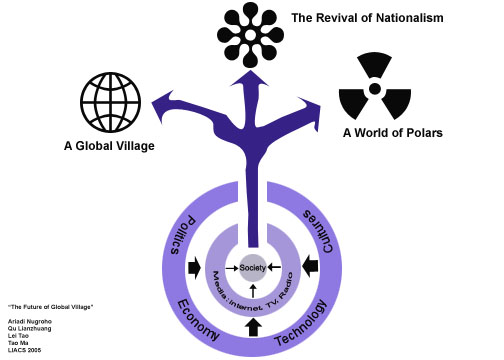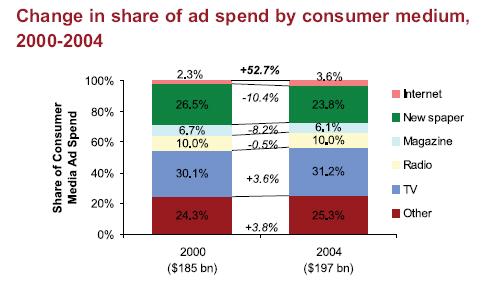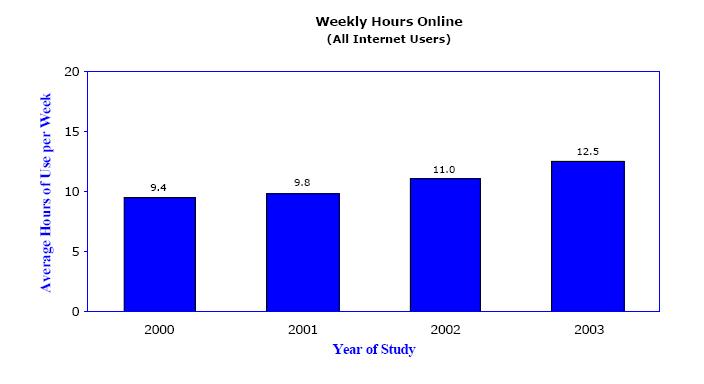Chen Li
Product of the future:
www.answers.com
Google is now the number one Internet brand. Its influence on people's life is significant. Who might challenge Google's position in the future?
www.answers.com might be one, it is a combination of wiki technology, dictionary, search engine, and online shops. Answers.com features a wealth of information about different topics, and uses Wikipedia for much of it. It collected authoritative facts by licensing top-quality reference work to give users reliable, concise, relevant information on each of over 3 million topics. The sources of the information include Houghton Mifflin, Columbia University Press, Thomson Gale, Computer Desktop Encyclopedia, MarketWatch, Investopedia, Who2, AccuWeather, etc.
When you type key words in, Answers.com will automatically provide you with answers in this sequence: Answers.com Directory(if not correct)->Dictionary(if not correct)->Wikipedia(if not correct)->Google, and at the same time provide you with relevant commercial information. For example, if we search 'scenario analysis' in answers.com, it will give the explaination from Wikipedia, because the keyword can neither be found in dictionary nor in its own database. If you are not satisfied with the result, you can further click the 'WEB' button and the page will provide you searching results with the keyword 'scenario analysis' from Google. On the right hand site of the page, 4 books on the the subject scenario analysis are listed, together with their prize and online ordering information.
What's google's reaction on this? Recently, Google stopped linking to definitions on Dictionary.com, and started linking to Answers.com instead. There are news that Google will buy answers.com and integrate it into Google, by doing that they can greatly improve their 'Google Q&A'.
A short vedio to introduce answers.com
http://www.answers.com/main/Record2?a=Answers.com%20ShortStoryMovie%20FromCompanyOverview&url=/resources/Answers.com_Short_Story.wmv
References:
http://www.kuro5hin.org/story/2005/6/12/143721/743
http://www.answers.com
http://www.wikipedia.com
Research questions:
Chen Li:
What are important non-technological trends which affect advertising?
Non-technological trends are direction or sequence of events that has some momentum and durability (from Kotler).
Globalization:
Globalization will bring changes in all levels from culture to communicating methods. Globalization is a very general descrpition, a 'megatrend' which influence almost every 'subtrends'.
One excisting model of scenarios analysis of globalization developed by last year's IIB students is illustrated below:

According to this model, the three different results means many different possible situations in culture trends, global ecnomic trends, social trends, etc. Forthcoming research questions will give detail analysis in these trends.
Product customization:
There is no doubt that the market differentiation is becoming more explicit. Certain groups of customers’ needs are unique. Their favor, and the way to reach them is diversified. The consistency of the advertisement's content, media type, targetd market, and the product's sustainable competitive advantage is the criteria for a eligible advertisment.
Economic trends
Ecnonmic trend can deeply influence people’s living style, purchase behavior, which has direct or indirect impact on advertising.
One forthcoming research question will give detailed explaination.
Culture trends
Because advertising is very culture sensitive, culture trends will certainly influence advertising.
One forthcoming research question will give detailed explaination.
Other trends
Social trends, political trends can also impact on advertising.
What are the social factors which will influence on advertising?
Protection towards Children There have been increasing efforts to protect the public interest by regulating the content and the reach of advertising. Some examples are the ban on television tobacco advertising imposed in many countries, and the total ban on advertising to children under twelve imposed by the Swedish government in 1991. Though that regulation continues in effect for broadcasts originating within the country, it has been weakened by the European Court of Justice, which has found that Sweden was obliged to accept whatever programming was targeted at it from neighbouring countries or via satellite.
In Europe and elsewhere there is a vigorous debate on whether and how much advertising to children should be regulated. This debate was exacerbated by a report released by the Henry J. Kaiser Family Foundation in February 2004 which suggested that food advertising targeting children was an important factor in the epidemic of childhood obesity raging across the United States.
In many countries - namely New Zealand, South Africa, Canada, and many European contries- the advertising industry operates a system of self-regulation. Advertisers, advertising agencies and the media agree on a code of advertising standards that they attempt to uphold. The general aim of such codes is to ensure that any advertising is 'legal, decent, honest and truthful'. Some self-regulatory organisations are funded by the industry, but remain independent, with the intent of upholding the standards or codes (like the ASA in the UK).
Critiques of the medium
As advertising and marketing efforts become increasingly ubiquitous in modern Western societies, the industry has come under criticism of groups such as AdBusters via culture jamming which criticizes the media and consumerism using advertising's own techniques. The industry is accused of being one of the engines powering a convoluted economic mass production system which promotes consumption. Some advertising campaigns have also been criticized as inadvertently or even intentionally promoting sexism, racism, and ageism. Such criticisms have raised questions about whether this medium is creating or reflecting cultural trends. At very least, advertising often reinforces stereotypes by drawing on recognizable "types" in order to tell stories in a single image or 30 second time frame. Recognizing the social impact of advertising, MediaWatch, a non-profit women's organization, works to educate consumers about how they can register their concerns with advertisers and regulators. It has developed educational materials for use in schools. The award-winning book, Made You Look - How Advertising Works and Why You Should Know , by former MediaWatch president Shari Graydon, provides context for these issues for young readers.
Public interest groups and free thinkers are increasingly suggesting that access to the mental space targeted by advertisers should be taxed, in that at the present moment that space is being freely taken advantage of by advertisers with no compensation paid to the members of the public who are thus being intruded upon. This kind of tax would be a Pigovian tax in that it would act to reduce what is now increasingly seen as a public nuisance. Efforts to that end are gathering momentum, with Arkansas and Maine considering bills to implement such taxation. Florida enacted such a tax in 1987 but was forced to repeal it after six months, as a result of a concerted effort by national commercial interests, which withdrew planned conventions, causing major losses to the tourism industry, and cancelled advertising, causing a loss of 12 million dollars to the broadcast industry alone.
Public perception of the medium
Over the years, the public perception of advertising has become very negative. It is seen as a medium that inherently promotes a lie, based on the purpose of the advertisement - to encourage the target audience to submit to a cause or a belief, and act on it to the advertising party's benefit and consequently the target's disadvantage. They are either perceived as directly lying (stating opinions or untruths directly as facts), lying by omission (usually of terms unfavorable to the customer), portraying a product or service in a light that does not reflect reality or even making up realities where their product has a new role.
Future
With the dawn of the Internet have come many new advertising opportunities. Popup, Flash, banner, and email advertisements (the last often being a form of spam) abound. Recently, the advertising community has attempted to make the adverts themselves desirable to the public. In one example, Cadillac chose to advertise in the movie 'The Matrix Reloaded', which as a result contained many scenes in which Cadillac cars were used. Similarly, product placement for Rolex watches and BMW cars featured in recent James Bond films.
Each year, greater sums are paid to obtain a commercial spot during the Super Bowl. Companies attempt to make these commercials sufficiently entertaining that members of the public will actually want to watch them.
Particularly since the rise of "entertaining" advertising, some people may like an advert enough that they wish to watch it later or show a friend. In general, the advertising community has not yet made this easy, although some have used the Internet to widely distribute their adverts to anyone wishing to see or hear them. Source: Wikipeida
What are the economic trends and how can it impact advertising?
First, we find the trends in Economy from Faith Popcorn's Popcorn report 1996, and listed it below. Second we will explain how can these trends impact advertising directly or indirectly.
Anchoring - The tendency to use ancient practices as anchors or support for modern lifestyles: aromatherapy, meditation, yoga, & Eastern religions.
- New lifestyles means new behaviors, also means new channels, new ideas for advertiseing.
Being Alive - The desire to lead longer and more enjoyable lives: vegetarianism, low-tech medicine, mediation.
ashing out - The desire for a simpler, less hectic lifestyle. A nostalgic return to small-town values.
- Above two trends are related people's attitude to life. According to that, advertisement with a 'fallow' style may be more popular.
Clanning - The need to join groups in order to confront a more chaotic world: Harley-Davidson's Harley Owners Group (Hog).
- People are willing to join groups, which means there can be ways to reach similar people more efficiently. TV advertisements broadcasted in Salons are good examples.
Cocooning - The impulse to stay inside when outside gets too tough and scary: redecorating, watching TV & rental movies, ordering from catalogs.
- No matter traditional TV will change to internet based or not, people will still spend much time watch TV programms and movies with their family theater. There are tools to block advertisements in TV, but it will still remain be the best way to reach your customers.
Down-Aging - The tendency for older people to act and feel younger than their ages: youthful clothes and hair coloring, adult toys, adventure vacations.
Egonomics - The wish to individualize oneself through passions & experience: customized goods, services, experiences.
- Advertisements will also be customized. Internet can achieve that easily, many search engines give you relevant commercials while searching.
Fantasy Adventure - The need to find emotional escapes: safari vacations, exotic foods.
99 Lives - Doing many things at once, "multitasking": cluster marketing enterprises-all-in one service stops.
S.O.S. (Save our Society) - The desire to make society more socially responsible: education, ethics, the environment.
Female Think - The recognition that men and women act and think differently.
Mancipation - The emancipation of men from stereotypical male roles of being macho and strong, and instead showing them as nurturing dads and concerned husbands.
- These are all trends that distinguish one group of people from others.
Small Indulgences - The desire to indulge in small-scale splurges to obtain an occasional emotional lift.
Pleasure Revenge - The proud and public pursuit of pleasure as a rebellion against self-control and self-deprivation.
Icon Toppling - The return to interest in smaller and more local organization and products.
- How can an advertisement give consumers this feeling.
The Vigilant Consumer - Intolerance for shoddy products and poor service.
- Quality of advertisement is important, too.
From the analysis above we can see that the economic trends have significant impact on people's lifestyle and consuming behaviors.
What affects the advertising budget?
www.doubleclick.com made an research on the current situation. According to their number, online advertisement spending grew 63% from 2000 to 2004 in absolute terms ($4.3 billion in 2000 to $7.1 billion in 2004). The Internet’s growth, meanwhile, was 52.7% as a share of total consumer media ad spending (excluding direct mail and yellow pages) in that same period. By comparison, overall ad spending in the same period on TV grew 10.6% in absolute terms (from $51 billion to $62 billion) and 3.6% as a share of total consumer media ad spending. The newspaper sector was the biggest loser in the media mix in terms of share of all ad dollars. Its readership is aging and declining, and its important base of classified ad revenue faces stiff competition online from the likes of eBay, Craig’s List, Monster.com and Match.com. Newspaper ad revenues were down 4.3% in absolute terms over the last five years ($49 billion to $47 billion), and they fell 10.4% in terms of share of media spend.
But those numbers do not tell the whole story. While at a high level, the growth of the industry remains steady and the budget allocation among media outlets is shifting only gradually.
Source: The decade in online advertising. www.doubleclick.com 2006
How much time does a person spend on Internet and watching TV? how will it influence advertising?
Number of hours people spend on Internet
Data source: Digital Future report 2004, by Jeffrey I. Cole, Ph.D., University of California.
Number of hours people watch TV
HOURS/PERSON/YEAR 1998 1999 2000 2001 2002 2003 Total Mdia Usage 3,347 3,469 3,519 3,570 3,623 3,661 Television 1,551 1,588 1,640 1,661 1,661 1,656 Broadcast TV 884 867 865 815 810 798 -Network stations 710 706 805 753 749 736 -Independent stations 174 162 61 62 61 61 Cable & satellite TV 667 720 774 846 851 858 -Basic 565 617 638 692 698 706 -Premium 101 103 137 154 153 152
Data Resource: FCC Annual Report 2003.
From the first figure we can see that the time people spend on Internet grew from 9.4 hours/week to 12.5 hours/week, a rise of 30%. And the time people spend on watich TV grew from 3519 hours/year to 3661 hours/year, that is 67.5 hours/week to 70.2 hours/week, a rise of 4%.
A reaserch made by the PRWEB company in 2006 shows that 55% of the online population uses the internet to search for local products and information in US. Source:http://www.wsicorporate.com/images/upload/211_StateoftheClickpr.pdf
We can see that till the year 2003, althrough internet usage is still grow at a high rate, but people still spend 57.7 hours more on TV, and there is no trend that this people will spend less time on TV now. In the newest release on March 07, 2006 of FCC's 12th annual report on TV competition, FCC declear that the death of TV hasn't quite happened yet as the average american household watched 8 hours and 11 minutes of TV per day last year. This was an all time record. The average american person in the average amercan household watched 4 hours and 32 minutes, another all time record.
A personal statics number shows that advertisement consist around 30% of total broadcasting time. http://www.waynesthisandthat.com/commerciallength.htm
Another news is that more and more people now get used to record TV programs, by which mean they can very easily skip all the advertisements. New products like Harddisk recorder, DVD recorder is becoming more and more popular.
From the consumer side, we can conclude that people are spending more time on Internet, people use Internet to search product information. The opportunity for online advertising is still growing. There is no trend that TV advertising will die, but there are certain threats like DVD recorders.
What are the legal issues?
The general rules of advertising are:
* advertising must be truthful and non-deceptive; * advertisers must have evidence to back up their claims; and * advertisements cannot be unfair.
Besides the generals, some addtional rules about Alcohol advertising, there are addtional rules and limits about protect children away from alcohol advertisements, the goverments also established self-regulatory program to let company regular themselves.
The Children's Online Privacy Protection Act, is a federal law that requires websites to obtain verifiable parental consent before collecting, using, or disclosing personal information from children, including their names, home addresses, email addresses, or hobbies.
Internet Advertising Advertising on the Internet subject to the same laws as other advertising. Ad claims on the Internet must be truthful and substantiated. The Rules of the Road for more information. Dot Com Disclosures offers special guidance for online advertisers regarding how to make sure that any disclaimers and disclosures in online ads are clear and conspicuous. It addresses 'Net specific issues such as banner ads, pop-up windows, scrolling, hyperlinks, etc. Internet marketers also should be aware that the FTC's Mail or Telephone Order Merchandise Rule ("Mail Order Rule") applies to online transactions.
Because the World Wide Web is, as its name implies, worldwide, even small online businesses can reach customers around the globe. Electronic Commerce: Selling Internationally - A Guide for Business discusses some online commerce guidelines endorsed by the United States government and 28 other countries.
Consumer privacy online Advertisers should be aware of the privacy issues raised by Internet marketing. The government strongly encourages companies to implement four fair information practices: giving consumers notice of a website's information practices; offering consumers choice as to how their personally identifying information is used; providing consumers with access to the information collected about them; and ensuring the security of the information collected. In addition, companies need to know about the Children's Online Privacy Protection Act and the rule that implements it. The law requires websites to obtain verifiable parental consent before collecting, using, or disclosing personal information from children, including their names, home addresses, email addresses, or hobbies. For more information, ask the FTC for How to Comply with the Children's Online Privacy Protection Rule.
Source: Federal Trade commission of US
Driving forces:
http://scenariothinking.org/wiki/index.php/Increasing_company_knowledge
http://scenariothinking.org/wiki/index.php/Legal_issues
Learning log: Use Systems thinking in Scenario thinking System thinking is a very standardize process. The basic logic of system thinking is to analyze the system, and categorize the interrelation into negative feedback loops and positive feedback loops. And by working on important feedback loops, which is known as ‘high leverage points’, we can change the system’s behavior more efficiently. In the theory, it said that the negative feedback loop keep system stable, while positive feedback tend to change the state of the system, so positive feedback loop was usually defined as harmful to the system, while negative feedback is usually defined as beneficial.
One pitfall about system thinking when I applied it to develop scenarios, is that I found it usually leads to conservative results. But the scenario theory told us, conservative scenarios usually do not have so much value because it is relatively obvious, thus all managers can see it if they do their homework. The value of scenario thinking lies in avoiding the situation of ‘Wrong when it hurt most’. In order to do that, the story needs to be both convincing and surprising. It sounds to be paradoxically. System thinking theory can easily make your story convincing, but to make the scenario surprising, we still need to use our imagination.
The reason made this happened, I think is because in the system thinking theory book, it concentrate too much on analyzing the negative feedback loops. Systems sometimes can also benefit from positive feedback loops. What is more important, positive feedback loops can also be very useful in developing good scenarios.
The invention of monofier in electronic engineering is an interesting case; normally engineers use negative feedback in circuit because it helps to get rid of the disturbance. But one engineer use positive feedback loop instead, and he invent the monofier which can generate electronic surge automatically. This story inspired us with ‘reverse thinking’. What will happen if we just leave the positive feedback in the system and let it develop by itself? Will it damage the system, or the system will adapt itself to find a new balance? What happened if we replace some negative feedback loop in the system with positive feedback loop, and the other way around? I think these are all useful questions to ask when developing scenarios.
In our research work of future of advertising, we experienced similar situations, too. System thinking first led us to conservative scenario. But as we continued to look for some ‘extreme’ scenarios, we find we are kind of blind and generally imagining stories. We did not find any methodology on how to develop surprising but convincing scenarios. However, Klaas-Jan and Sven in our group came with some ideas of government control and ‘pull’ advertising. The ideas sound great, but the problem remains that although we know our target, we still suffered in finding a way led us to there. That is why our finial story sounds not convincing enough. After we finished our project, I think now I have some ideas about how to use system thinking in develop good scenarios as well. In the case, we can define people’s attitude to advertising and advertiser’s behavior as a positive feedback loop, as people are trying to get rid of advertisements, advertisers will strive to find new ways to reach people, thus result in more resistance. If this positive feedback continues, there would be one day people tried to fight with advertisers and call for government control. But if we replace this positive feedback loop with negative feedback loop, we will easily go to the question: what happened if advertisers stop pushing, but ‘pull’ advertisement from people? Similarly we can find negative feedback loops in the system: people’s attitude toward personalized advertisement will lead to tight laws controls on privacy issues, and advertisers have to follow the rules. If we replace it with a positive loop, we can come to this question: what if advertiser’s influence to politicians makes them decide companies can use people’s personal information with relatively less restrictions? Is it possible that became a trend and influence advertising in the future? Of course, this is just one example. But I think this new thinking of finding positive feedback loops to help to develop scenarios will be very helpful.
Therefore we can find another way of developing scenarios:
 Of course, scenario planning has many other methodologies, and I just gave my suggestion based on very limited personally experiences. And there are risks in this way of developing scenario; we still need common sense to sustain our story. I think system thinking is very helpful in analyzing the research topic and the environment as a whole. To combine it with scenario planning, concentrate more on the positive feedback loops, and apply reverse thinking to high leverage feedback loops could be a helpful methodology.
Of course, scenario planning has many other methodologies, and I just gave my suggestion based on very limited personally experiences. And there are risks in this way of developing scenario; we still need common sense to sustain our story. I think system thinking is very helpful in analyzing the research topic and the environment as a whole. To combine it with scenario planning, concentrate more on the positive feedback loops, and apply reverse thinking to high leverage feedback loops could be a helpful methodology.


